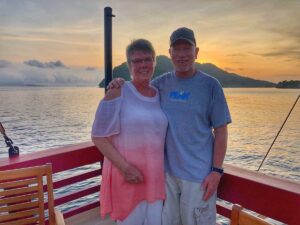By Rod Salm
A Heavily Pregnant Manta
Snorkeling and diving with mantas at Manta Alley are always very rewarding and I always do both. Diving gets us down to the cleaning station where, if one is careful and patient, the huge mantas will come in close and hover as they are stripped of parasites by a host of fishes.One of the highlights was seeing A Heavily Pregnant Manta glide gracefully by.
Our visit in May 2019 was no exception. We entered early when the low morning light filtered weakly through plankton rich waters. It gave a ghostly effect to the giant mantas gliding effortlessly down and around us. But for the rasp and rattle of our regulators and the persistent pull of current in places, it was a serene scene. We needed to be deep for that.Among them was a sight I’ll never forget A Heavily Pregnant Manta.
Nonetheless, I prefer snorkeling. I love to float, sink, wait, and leave the mantas to wing their way to me unencumbered by a wall of bubbles between us. Hovering just above the rounded rock boulders on the bottom, I had a huge black manta glide straight toward and only inches above me time and again. I marveled at the sheer bulk of the animal, not realizing then that she was heavily pregnant.
Looking at my photos confirmed her pregnancy, and the lacerations on her left pectoral fin absolutely clinched it. These are caused by the male biting onto to it to hold the female steady while they mate. Incubation lasts about a year. A heavily pregnant manta is ovoviviparous, meaning that their eggs hatch in utero and the hatched mantas grow inside their mothers until ready for birth.
They are fully developed and independent at that stage. Mantas give birth to one or two pups. From the symmetrical swellings on the back of this manta, it looks like she might be reading herself to give birth to two pups. They will emerge in the right place: a plankton rich soup to nourish their early growth.
Last year, also in May, we had memorable magic moments snorkeling with feeding mantas at Fishbowl in the north of Komodo National Park. These were smaller mantas and in their midst one one recently born that still bore the wing fold marks on its back.
May could well be a month for mantas to pup here. It is wonderful to see it still happening and the population replenished. If these mantas keep close to home and within the boundaries of Komodo National Park, we will be snorkeling and diving with them for decades to come.
To learn more about the fascinating reproductive behavior of mantas, click here
Rod Salm
May 2019
NOTE :
To reserve your spots or see available trips, please check out our schedule page :
Schedule & Availability
Please also don’t hesitate to reach out to us at [email protected] should you require any further information or need recommendations for accommodation or flights etc. Our reservation team would be more than happy to assist. Cheers!
Follow us on instagram or Contact Us for more information about
A Heavily Pregnant MantaA Heavily Pregnant MantaA Heavily Pregnant MantaA Heavily Pregnant MantaA Heavily Pregnant MantaA Heavily Pregnant MantaA Heavily Pregnant Manta





